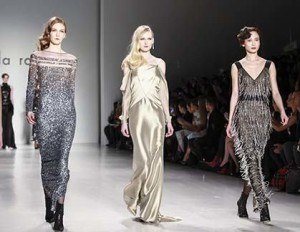Fashion Design
School and Career Guide
Get the information you need to begin your fashion design education or career.

Overview
Fashion Design and Beyond
While fashion design jobs get a lot of attention for being the creative driver of the industry, the fashion world is actually a complex ecosystem with a large community performing a wide variety of essential functions. Designing is only one part of the whole. So whether you have the creativity and vision to launch your own clothing line, or the business and marketing know-how to sell the latest trends, there's a place for you in the fashion industry.
Who Are Fashion Designers?
Fashion designers understand that clothes are much more than protection from the elements. Clothes can make people feel confident or powerful. Or they can be comforting. Clothing can be an artistic expression—a projection of the image people want the world to see. Here are some of the traits and skills needed to be a successful fashion designer:
| YOU ARE … | YOU SHOULD HAVE … |
|---|---|
| Original and innovative | Great deductive reasoning |
| Enterprising | Good decision making skills |
| Dependable | Good communication skills |
| Organized | Good listening abilities |
| Independent | Good coordination |
| Have excellent attention to detail | Good judgment |
Who Are Fashion Merchandisers?
Every great boutique or department store needs a Wizard of Oz—someone behind the curtain making everything appear as impressive as possible—someone deciding to stock ruby slippers because they're the next big thing. Fashion merchandising experts accomplish tasks like these on a regular basis. Here are some of the traits and skills you'll need in a fashion merchandising career:
| YOU ARE … | YOU SHOULD BE … |
|---|---|
| Visually creative and enterprising | A good listener |
| Physically coordinated | Able to articulate ideas |
| An innovative thinker | A good critical thinker |
| A good decision-maker | A good time manager |
| Organized and good at arranging | Socially perceptive |
Where do you fit better? Both designers and merchandisers are critical to the fashion industry. Knowing yourself and your abilities will help you find your niche in the competitive, fast-paced global fashion world. All you'll need to add is the right education.

Degrees
Learn about the classes you'll get to take in fashion design college.
Aspiring fashion designers can look forward to their share of excitement in their chosen field; however, there are many technical aspects of a fashion design job as well. You can earn a two-year associate's degree in merchandising, or expand your skills by earning a four-year bachelor's degree in fashion design, which will also provide coursework in the merchandising, business and marketing facets of fashion.
Fashion Design Course Curriculum
Depending upon which facet of fashion you want to study at your college, you will hone your technical abilities and your knowledge of the industry. Let's take a look at the types of courses in design and fashion marketing and management you'll take and the information you'll cover as you work toward the completion of your degree:
Fashion Design
- Art and fashion history
- Collection and concept development
- Digital color and design theory
- Computer aided fashion design
- Fashion illustration
- Costume design
- Draping
- Fashion merchandising
- Fashion sketching
- Management
- Patternmaking
- Computer Patternmaking
- Portfolio preparation
- Principles of design
- Professional practices
- Sewing and garment construction
- Studio courses
- Textiles and fabrics
- Portfolio
Fashion Marketing and Management
In this field you will take many of the same classes in the fashion design program, however your main focus will be on the business and marketing aspects of fashion, as well as product development, branding, learning how the consumer behaves, and developing your ability to forecast fashion trends.
- Business law and intellectual property
- Design trends and forecasting
- Product development
- Merchandise presentation
- Marketing
- Brand management
- Advertising
- Store operations
- Digital marketing strategies
- Merchandise buying
- Finance
- Inventory and stock control
- Event planning, promotions and public relations
- Fashion journalism
- Entrepreneurship
- Consumer behavior
If these sound like a challenge you'd like to accept, start your research for the right fashion design course program in your area.

Online vs. Campus
Here's what you can—and can't—learn in an online fashion design degree program.
If you're dreaming of a fashion design career, but not sure how you'd ever fit the necessary training into your schedule, you could consider earning your fashion design degree online. But you'll need to weigh reality with availability first. For example if you want to go into the business, retail management, or retail merchandising side of fashion, you're definitely in luck as far as online courses go.
But if you want to enter the dynamic realm of fashion designing, you'll need to be in a classroom or studio setting to interact with textiles and fabrics and understand how they'll drape on a model. That said, you may be able to take part of your coursework online. You can fulfill your history of fashion, fashion business law, and other survey courses online. As computer aided design (CAD) becomes more prevalent within the industry, you'll find classes online in fashion design technology, and you may just ultimately decide that a hybrid program mixing online and classroom set studies is best for you.
Three Reasons to Earn Your Degree Online
If you're considering an online degree program take this to heart—you'll want your fashion design program to be accredited by the National Association of Schools of Art and Design (NASAD) or one of six regional accrediting agencies. Accreditation ensures a quality program reviewed by academic peers, may allow you to seek financial aid, and makes sure that your credits will transfer if you move or go to another school later on. Since NASAD is slowly accrediting online programs you may have some difficulty finding online schools with their seal of approval, though regional accrediting bodies readily approve online programs.
What are the top three reasons people earn a degree online?
1. Learn anywhere, anytime.
The most obvious benefit of earning your fashion design degree online is that you can learn anywhere you have a computer and an Internet connection. And while you may have to meet certain deadlines in completing your course work, your day-to-day class schedule is generally up to you.
2. Learn at your own pace, and fully absorb the material.
Because online courses offer lectures in either written or video format, you'll automatically be able to work through these materials at your own pace and to review them as often as you need to in order to absorb key concepts.
3. Enjoy lots of direct communication with your instructors—and your classmates.
One irony of online fashion degree courses is that they often end up being more interactive than real-world classes. Email, message boards, IMs, Skype, Blackboard and online chat will allow you to keep in constant touch with your professors and classmates—and you'll be expected to communicate regularly via these channels.
What Will You Study Online?
We've already talked about what you won't study online in a fashion design course, so let's look at some of the curriculum for the retail management and merchandising track as from The Art Institute Online Program:
Bachelor's Degree – Fashion Marketing & Management – The Art Institute of Pittsburgh Online Division
You'll take core courses such as:
- Consumer Behavior & Persuasive Sales Techniques
- Brand Strategy
- Textile Fundamentals
- Early – Modern History of Fashion
- 3D Visual Merchandising
You'll also take three core elective classes such as fashion drawing, merchandising menswear, or fundamentals of web design. Besides industry-related topics, you'll take some general education classes, such as college math or composition and language as well as 10 general education courses in social science, humanities and science.

Salary
Find out what you can expect to earn in your fashion designer career.
Information About Fashion Designer Salaries
While the fashion design industry's household names probably earn hundreds of thousands or even millions of dollars, this might be a little out of reach for the average fashion designer. An entry-level fashion designer salary is far from the million dollar mark, but overall, this is a well-paying career with potential for growth.
How Much Do Those in the Fashion Industry Earn?
There are a number of factors that influence your fashion designer salary. Name recognition and experience level are two of the big ones, but there are a few more things that may also contribute to building up your bank account, such as where you work and your years in the field. According to the 2023 U.S. Bureau of Labor Statistics Occupational Employment Statistics, here are median annual salaries for professionals involved in careers in fashion.
| FASHION INDUSTRY CAREER | MEDIAN ANNUAL SALARY |
|---|---|
| Fashion Designer | $79,290 |
| Merchandise Displayer | $36,230 |
| Tailors, Dressmakers, Custom Sewers | $36,650 |
The salary information listed is based on a national average, unless noted. Actual salaries may vary greatly based on specialization within the field, location, years of experience and a variety of other factors. National long-term projections of employment growth may not reflect local and/or short-term economic or job conditions, and do not guarantee actual job growth.
Are There Jobs Out There?
The fashion industry is mostly growing internationally as most houses and manufacturers produce clothing overseas to avoid higher costs at home. The U.S. Bureau of Labor Statistics states that it may be necessary to relocate to New York or California, which are hubs for the industry, in order to find a career.
Job growth for fashion designers is expected to increase 3.3% through 2032, slower than average for all careers. However, designers will still be needed to design clothing using new types of materials, such as sustainable clothing or moisture-wicking fabric clothing. Read more about career outlook for fashion designers.

About the Job
Find out what a fashion designer job is really like.
While good fashion design will never bring about world peace, fashion can make a person feel better. Whether you think of royalty or rock stars, you visualize their appearance and presentation. What people wear projects who they are.
The sophisticated and often over-the-top styles found on the runways of Paris and New York do not represent the full spectrum of fashion designers' work. In reality, there are a multitude of opportunities in fashion design, from sportswear, to children's clothes, to haute couture. If you can wear it, someone has designed it.
Common Tasks
As a fashion designer, your job description may include a variety of tasks. Designers may be responsible for the following:
- Attending national and international fashion and trade shows
- Researching and predicting fashion industry trends
- Staying current on contemporary styles
- Putting together a cohesive collection theme
- Creating sketches and samples
- Choosing fabrics and colors
- Using computer-aided design programs (CAD) to produce designs
- Doing fittings and making alterations
- Pricing and marketing products
- Working with creative directors, models, tailors, patternmakers and clients
- Performing business administration tasks
Essential Skills for a Fashion Designer Job
- Creativity and Style – The fashion design industry is in a perpetual state of metamorphosis. Fashion designers need to draw inspiration from past trends and see new possibilities for their future designs. They need to innovate and put a fresh spin on things. From sketching to execution, fashion designers need artistic ability and originality to succeed in the industry.
- Knowledge of Fashion History – Fashion designers have to be a step ahead. To do that, they need knowledge about previous styles and movements in fashion history. They also need to be aware of current fashion events and developments.
- Business Know-How – Knowing the ins and outs of business is essential for any fashion designer. In this highly competitive industry, aspiring designers can't rely on their artistic vision alone to bring success. For fashion designers, understanding basic principles of marketing and business can help them reach their goals.
- Ability to Perform Under Pressure – A fashion design career isn't for the faint of heart. Fashion designers should thrive in high-pressure environments. Those entering this occupation should be willing to work in a team, and they should work well under the demands of deadlines. They should also be able to handle criticism. Critics can be brutal. Successful fashion designers know how to learn from a critique while maintaining their individual style.
Categories
Fashion Design Degree & Career Guide
- 5 Ways to Prepare for Fashion Design School
- A Fashion Designer Speaks from Experience
- A Fashion Graduate from the Art Institute Tells Her Story
- All About the Fashion Design Industry
- Choosing a Fashion Design School
- Cities on the Fashion Week Honor Roll
- Degrees in Fashion Marketing
- Fashion Career Paths: Find Your Niche
- Fashion Design Collages: Your Path to Fashion Inspiration
- Fashion Design School and Career Guide
- Fashion Stylist Job Description
- Fashion Week Kicks Off
- New York: Fashion Design Capital of the U.S.
- Popular Fashion Schools
- Tips for a Fashion Design Career
- Trends in the Fashion World
Fashion Merchandising Degree & Career Guide
You may also like

Degrees in Fashion Marketing

Fashion Week Kicks Off

